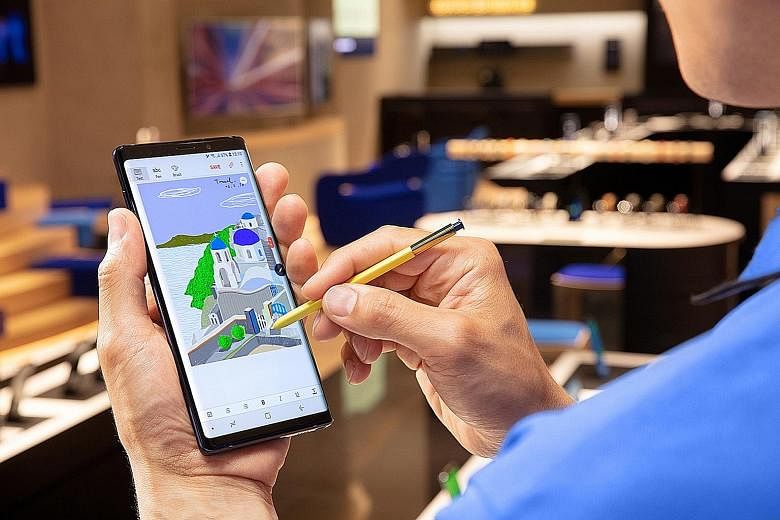Samsung single-handedly created and popularised the phablet (phones with big screens) genre when it launched the 5.3-inch Galaxy Note, which comes with a stylus, in 2011.
Since then, other vendors have joined in and the phablet is now the norm in the smartphone market.
So, what is Samsung's latest response to stay ahead of the game? Pack the biggest screen, largest battery and most powerful processor in the Note series, with a better stylus, top-notch rear dual-camera system and water-carbon cooling system into a sleek metallic powerhouse that is the new Galaxy Note9.
This 6.4-inch smartphone will be available on Saturday.
DESIGN
These upgrades are not visible when you first look at the Note9, as it looks like last year's Note8.
Physical differences are minute, with the Note9 being 0.2mm thicker, 1.6mm wider, 0.6mm shorter and 6g heavier than the Note8.
-

TECH SPECS
PRICE: $1,398 (128GB), $1,728 (512GB, version tested); available on Saturday
PROCESSOR: Exynos 9810 (quad-core 2.7 GHz + quad-core 1.7 GHz)
DISPLAY: 6.4-inch, Quad HD+ Super Amoled, 2,960 x 1,440 pixels, 516 PPI pixel density
OPERATING SYSTEM: Android 8.1
CAMERA: 12MP, f/1.5 wide-angle, 12MP, f/2.4 telephoto (rear); 8MP, f/1.7 (front)
MEMORY: 6GB RAM (128GB version), 8GB RAM (512GB version)
BATTERY: Non-removable 4,000 mAh
WEIGHT: 201g
-
RATING
FEATURES: 5/5
DESIGN: 5/5
PERFORMANCE: 5/5
BATTERY LIFE: 5/5
VALUE FOR MONEY: 4/5
OVERALL: 5/5
But the most visible external change is also the most welcome. The rear fingerprint sensor has been moved to under the rear dual-camera unit in the Note9. No more smudging the camera lens while trying to unlock the phone, as was the case with the Note8, where the fingerprint sensor was sited beside the camera lens.
The Note9 sports a slightly larger 6.4-inch Amoled display, up from the Note8's 6.3-inch display.
It might sport the same resolution of 2,960 x 1,440 pixels, but the display is probably the best I have seen on a smartphone. It exhibits great brightness, vibrant colour and superb details. It is pure joy watching movies and playing games on the phone.
A bit of nitpicking: If you look closely, you will find the Note9's screen bezel a wee bit thicker than Note8's.
In Singapore, the Note9 will be available in three colours - midnight black, metallic copper and ocean blue (version tested).
I usually prefer my gadgets to be black and inconspicuous. But the blue model can look both striking and inconspicuous. Its metallic-blue shade turns from dark to shiny blue depending on its angle against the light.
The blue Note9 is the only model that comes with a yellow-gold S Pen stylus, while the other models have an S Pen of a matching colour.
Initially, I thought a matching blue S Pen would have been more apt. But after using the S Pen for two weeks, I have grown to appreciate its unique colour that makes it easy to spot.
S PEN
The new S Pen now comes with Bluetooth Low Energy support, which allows it to be used for more than just scribbling and drawing. You can now use the S Pen as a remote control within a 10m radius.
For example, you can use the S Pen as a remote shutter release for the Note9's camera. Press and hold the S Pen button to launch the camera. Once the camera is switched on, click once to take a picture. Double-click to change from the rear camera to the front-facing camera to take a selfie.
The new S Pen can also be used to browse and review the pictures you have taken, as well as pause and play videos.
You can even use the S Pen as a clicker for your slide presentations. This is especially useful as the Note9 natively supports Samsung DeX, a technology that turns certain Samsung flagship smartphones into a desktop PC when hooked up to a monitor.
The DeX PC-like interface used to be possible only via a DeX dock. But now, you just need to connect the Note9 to a monitor via an HDMI adaptor to activate DeX.
I used the HDMI-to-USB-C adaptor that I usually use with my MacBook Pro and DeX worked like a charm when I connected the Note9 to my monitor.
Once connected, the Note9's display becomes a touchpad to control the mouse cursor. You can also activate a virtual keyboard on the display to work on your proposals or presentations.
This means mobile warriors do not need to take along a laptop for presentations.
The S Pen lasts about 30 minutes or 200 clicks of the S Pen button. But thanks to its supercapacitor battery, it charges fully in about 40 seconds when you stow it away in the phone.
PERFORMANCE
For the Singapore market, Samsung has armed the Note9 with the Exynos 9810 octa-core processor, which is said to provide 33 per cent faster processing performance and 23 per cent faster graphics performance than the Note8.
In addition, the Note9 comes with at least 128GB of internal storage and 6GB of system memory. My review unit is the high-end 512GB model that comes with a whopping 8GB of system memory.
With a microSD card slot that can expand the smartphone's storage by up to 512GB, you can have 1TB in your smartphone - more than the storage of some laptops on the market.
In the GeekBench 4 benchmark test, the review unit scored an impressive 3,760 points (single-core) and 9,094 points (multi-core). By comparison, the Note8 scored 1,960 points (single-core) and 6,472 points (multi-core).
Playing the graphics-and resource-intensive popular survival shooter Fortnite felt as smooth as silk. The smartphone does get warm when playing Fortnite, but the warm temperature remained fairly constant even when I played it for an hour.
BATTERY
With a 4,000mAh battery, the Note9 is said to last a whole day.
Mileage, of course, depends on your usage. During my tests, I found that in a typical 12-hour work day with regular checking of Facebook and Instagram feeds, the Note9 was still left with 40 per cent battery life at the end of the day.
In The Straits Times' video-loop battery test, it lasted 15 hours 27 minutes, which is very impressive.
CAMERA
The Note9 uses the same splendid rear dual-camera system of the Galaxy S9+, which comprises two 12-megapixel cameras, with one having an f/1.5 wide-angle lens and the other an f/2.4 telephoto lens.
Image quality is superb for a smartphone camera, with sharp details and accurate colour reproduction in most situations.
The Note9's camera gets a new Scene Optimiser function, which enhances photos automatically according to whether they are landscapes, portraits or other types of photos. This works in the background and, often, you do not even know that it is working.
I found this feature to be a hit-and-miss. At times, it does make a landscape photo look more saturated. At other times, it does not do anything for the same scene.
Another new feature is Flaw Detection. The camera will automatically warn you about a person blinking his eyes or a shot being blurry or backlit.
Again, this is rather inconsistent. I tried taking a few selfies while blinking my eyes. Half the time, there was no warning.
• Verdict: The Samsung Galaxy Note9 might not have any radical improvement from its predecessor. But the improved performance, better battery, built-in DeX support, great camera and the Bluetooth S Pen stylus make it a well-rounded smartphone that you can use as a daily workhorse and as an entertainment device.


